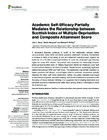Academic self-efficacy partially mediates the relationship between Scottish index of multiple deprivation and composite attainment score
Citation
Perry JL, Dempster M and McKay MT (2017) Academic Self-Efficacy Partially Mediates the Relationship between Scottish Index of Multiple Deprivation and Composite Attainment Score. Front. Psychol. 8:1899. doi: 10.3389/fpsyg.2017.01899

View/
Date
2017Author
Perry, John
Dempster, Martin
McKay, Michael T.
Peer Reviewed
YesMetadata
Show full item record
Perry JL, Dempster M and McKay MT (2017) Academic Self-Efficacy Partially Mediates the Relationship between Scottish Index of Multiple Deprivation and Composite Attainment Score. Front. Psychol. 8:1899. doi: 10.3389/fpsyg.2017.01899
Abstract
A developing literature continues to testify to the relationship between higher socio-economic status (SES) and better academic attainment. However, the literature is complex in terms of the variety of SES and attainment indicators used. Against the backdrop of a Scottish Government initiative to close the attainment gap between higher and lower SES children, the present study examined the relationship between individual-level Scottish Index of Multiple Deprivation (SIMD) and National Lower Tariff Score in school children in the West of Scotland. Results showed a practically significant relationship between SIMD and Tariff Score. This relationship was partially mediated by higher academic self-efficacy, so that higher belief in academic competency partially mediated the SIMD-Tariff Score relationship. Further, this partial mediation was robust to the influence of gender, sensation seeking, level of school attendance and past month frequency of Heavy Episodic Drinking. It is suggested that increasing attendance and perceived academic competence are viable ways (among others) of attempting to close the attainment gap.
Keywords
ScotlandAttainment
Tariff score
Academic self-efficacy
Heavy episodic drinking
School attendance

